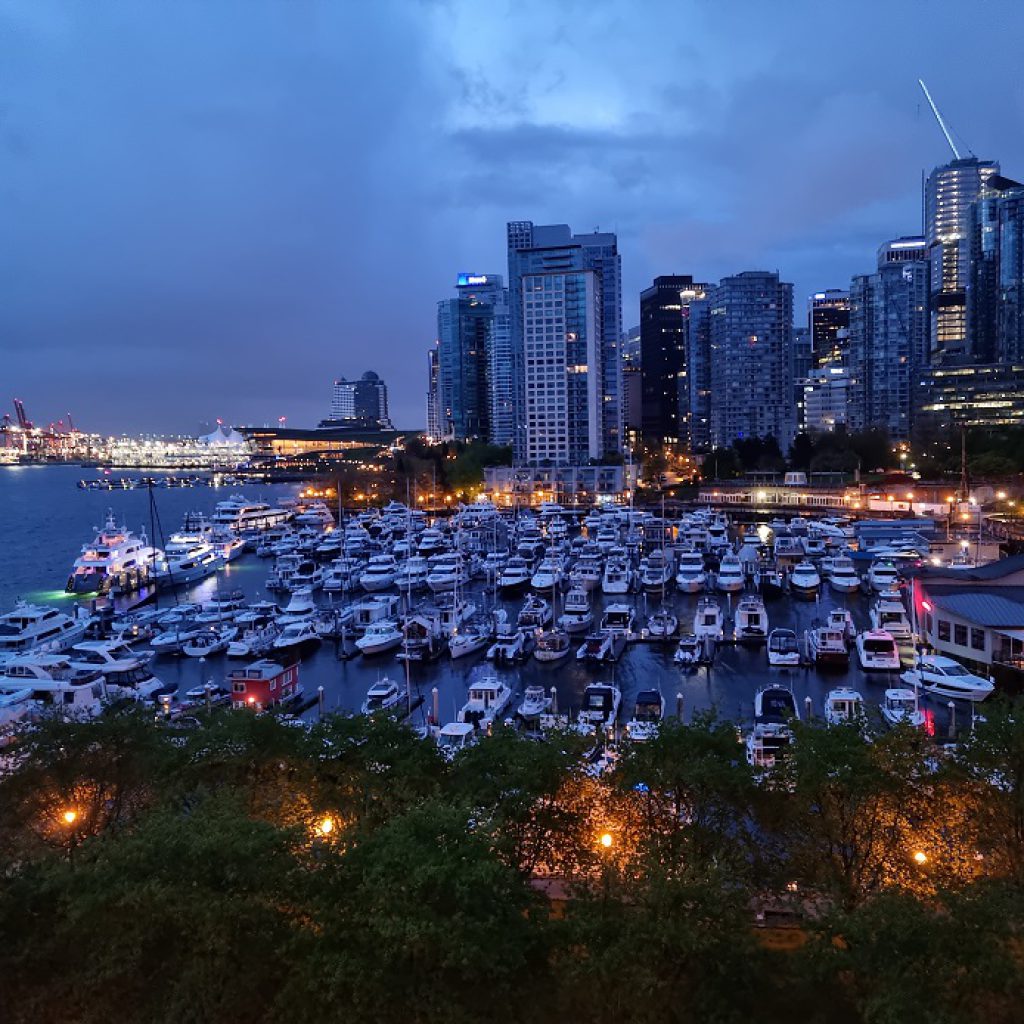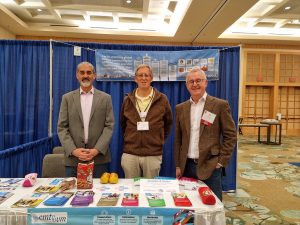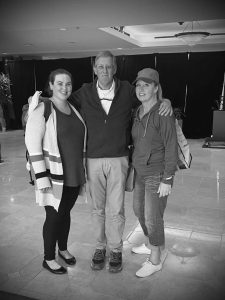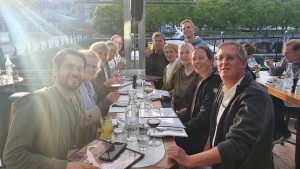The ISSVA (International Society for the Study of Vascular Anomalies) is a multidisciplinary international organization of doctors, scientists and healthcare providers united by an interest in vascular anomalies.
Once every 2 years, the ISSVA organizes a worldwide conference. For 2022 the conference was held in Vancouver (Canada) from May 10-13.
We were able to combine our participation in the conference with a meeting with our Canadian Patient Advocates Jodi & Katie. We worked closely together on developing Patient Advocacy in Canada for our organization.
The conference could be attended both in person and ‘online’. Around 300 people were present in Vancouver, which were mainly medical specialists.
On Monday evening, May 9, the ISSVA conference was informally opened with drinks. After two years of not being able to meet each other in person, due to the COVID-19 pandemic, it was particularly good to see each other and catch up.
Pre-conference
Tuesday was a pre-conference day. Various presentations were given and at the end of the day medically complex patients were discussed.
One of our advisors, Prof. Dr. Laurence Boon, gave a presentation on the differences between ‘clinical trials’ and ‘compassionate use’. This concerns the use of new medicines. Of course, these should not be prescribed to people without proper considerations.
This is preceded by a long process. At the end of a drug development process, the drug must be tested in humans. In this world this is called ‘ clinical trial’ and this is a very long and well-documented process with all kinds of control mechanisms and the results of which are extensively recorded.
In certain cases, the need may be so great that the ‘clinical trial’ process would take too long and then there is a quicker path called ‘compassionate use’.
The main differences between these two processes are:
| Clinical trail | Compassionate use |
|---|---|
| Registered, publicly accessible | Not registered |
| Future | Future & past |
| Goals: Primary & Secondary | Outcomes |
| Detailed and rigid protocol (ICF, inclusion/exclusion criteria/monitoring, risks, …) | No detailed protocol |
| Strictly regulated | Not regulated |
About surgery and interventional radiology (*)
Surgery has become less important over the years. There is certainly a role, sometimes for severe or threatening symptoms or obvious cosmetic problems, but often only as additional treatment.
Surgery after interventional radiology, after/during drug therapy. However, without surgeons, the team is not complete in all phases to make the right assessments with regard to the various possible therapies (in a Multi-Disciplinary Consultation). The number of patients obtaining the best results with interventional radiological treatments alone is also declining somewhat because drug therapy has developed considerably.
About medication (*)
The drug treatment options for symptomatic patients with vascular malformations and tumors are increasing and we also see a greater role for specialists such as haematologists, vascular physicians and paediatricians in the centers of expertise. And they also know how to find the ISSVA in larger numbers. Medication is thus a growing addition to the treatment arsenal of patients with vascular anomalies. For example, treatment with atenolol, propranolol, fraxiparin, DOACs, sirolimus, alpelisib, trametinib, thalidomide, etc. can offer a patient a positive outcome who does not benefit enough or not at all from conservative treatments or invasive techniques such as interventions and surgery. Of course, depending on side effects, drug therapy on its own can be chosen. And whether this is based on genetic mutation analysis and known pathological “pathways” or is started empirically because we can no longer offer alternative treatments and the suffering is too great, it gives hope and opportunities for fewer symptoms. All this means that an even better quality of life is achievable for the patients. New medicines are on the way and hope remains for the “golden bullet” (Fran Blei). Unfortunately, this has not yet been found. However, the use of current resources can also be used peri-procedurally so that invasive treatment is associated with fewer complications (e.g. peri- and post-operative bleeding). “Neo-adjuvant” use of medication can still make surgery possible for initially inoperable abnormalities due to “downsizing”. All in all, medication is very promising, but the holy grail has not yet been found.
About infantile hemangiomas – IH (*)
Since 2008, propranolol has been the main treatment for IH. Other beta-blockers are now also being used for the treatment of IH. In addition to propranolol, there is also a lot of experience with atenolol in the Netherlands. A study carried out in Rotterdam and Utrecht was presented. This study looked for a possible difference in efficacy between propranolol and atenolol. No differences or other long-term effects were found between children treated with propranolol and children treated with atenolol.
About mutations and the role of genetic diagnostics (*)
We are gaining more and more insight into the genetic origin of vascular malformations. Knowledge in this area is growing and many studies that have been conducted and presented have a focus on genetics. In addition to the clinical presentation, complaints, localization(s) and the presence or absence of haematological abnormalities, the outcome of DNA mutation analysis is indispensable in understanding the pathophysiology and treatment options. Whether it concerns (non-exhaustive or classifying) ACVRL1, (K)RAS, MAPK, PIK3CA, TIE2/TEK, BRAF, RASA1, MTOR or AKT1, inhibiting the (associated) “pathways” provides new possibilities but also brings along with it new risks and questions. To what extent is inhibition (or long-term inhibition) of the activation safe for the patient and what dosage is correct? What is the role of double mutations? Do we treat genotype, phenotype or the whole patient?
About cell -free DNA (*)
Mutations in the (affected) tissue of patients are becoming increasingly important for the diagnosis of vascular malformations. Obtaining tissue is sometimes difficult (not safely accessible, painful procedure, scar, bleeding, infection). There are more and more initiatives to extract DNA from circulating blood (and cysts). A striking finding is that it may be easier to obtain DNA in the blood after embolization (1 hour after). This technique will be developed further.
About GNAQ-209 Positive Port-wine Stains (*)
It was already known that a change in a certain gene leads to a certain group of clinical disorders. In the meantime, it has been found that different mutations in one gene can also cause different disorders that behave differently clinically. For example, GNAQ mutations give a picture of wine stains or Sturge-Weber syndrome (SWS). It turns out that two different mutations can be found in the GNAQ gene: Gln209Leu and Arg183Gln. The Arg183Gln variant is more common and milder, but associated with SWS. The Gln209Leu variant leads to a stronger activation in skin tissue.
Port-wine stains with the 209 variants can lead to ulceration (spontaneous sores). Although rare, this picture has also been seen in the Nijmegen patient group. This also shows that different mutations in one gene can give very different outcomes.
About GNA11_SWS (*)
In addition to a GNAQ mutation, the GNA11 mutation can also cause port-wine stains and show symptoms similar to Sturge-Weber syndrome. For the GNA11 mutation, the SWS picture appears to be milder than for the GNAQ mutation. The expertise centers from Caen, Brussels and Nijmegen collected 3 patients who described this milder SWS problem.
This co-production was presented at the ISSVA meeting by one of the publication’s authors.
And now? (*)
In short, a lot of new DNA mutation diagnostics are possible and the results are more and more relevant for clinical treatment in the context of the choice of therapy and in particular medication. The fast expansion of knowledge cannot be handled by one individual doctor and, in addition to a coordinating practitioner, the patient needs a team in which all members contribute state-of- the – art knowledge in this area. It is also necessary to supplement and revise (national) information material.
About PROM’s, HRQOL, OVAMA and SDM (*)
In addition, research will also have to be carried out into the most cost-effective diagnostics and treatment so that the macroeconomically limited financial resources and capacity can be used to contribute, in the best way, to the quality of life for the patient. Attention was also paid to this during the conference in the various presentations and discussions. A number of projects such as PROMIS and PROVAM focus specifically on improving the measurement of quality of life. Time and time again it becomes clear that pain has an important negative influence. Many invasive treatments cause an acute period of extra pain on top of the often chronically present pain complaints. When it is expected that frequent treatments will be necessary, it is important that this aspect is taken into account when choosing the treatment process (“shared decision making”). The process of SDM can be supported by multimedia educational material as presented and evaluated at the congress (“PEMAT-A/V survey”). The DECLARATION project has once again shown that we as practitioners can still improve the SDM process.
Classification (*)
In many cases, multimodal personalized therapy in close consultation with the well-informed patient is therefore the best strategy for tackling a congenital vascular anomaly symptoms. The insights surrounding “our” diseases based on genetic pathophysiology are rapidly changing and the discussion surrounding any necessary adjustments to the 2018 ISSVA classification is ongoing. There have been good discussions about this and much more consultation will follow in the near future. The classification will in any case be brought up to date and the accessibility will improve, with at least more clinical descriptions being added. Whether the classification will change radically remains uncertain for the time being.
Some further discussions will follow in this regard.
CMTC-OVM booth
We also had a ‘ booth ‘ in a separate room where we presented our organization through a whole series of new leaflets, booklets and a new banner. Of course, we had brought a large amount of stroopwafels and chocolate, which were again very well received!
Our ‘booth’ had a typical Dutch look with, among other things, small wooden clogs and ‘clog slippers’.
This conference has resulted in a number of new and interesting contacts and the necessary actions such as sending a series of packages with our new information material.
Our ‘ booth ‘ has resulted in a whole set of new medical contacts from countries with which we did not yet have contacts (such as Spain, Columbia and Vietnam). Our leaflets and booklets stood out clearly and a lot of material was taken by booth visitors.
For example, we can have our leaflets and booklets translated into even more languages through our new contacts and then they will have this material available in their own language so that they can present it to patients, their families and healthcare professionals.
One of our advisors Millan Patel lives in this area so we could catch up. Millan has written an article on the CMTC classification that is currently being reviewed. As soon as this article is available we will publish it and bring it to the attention of other medical specialists.
In Canada, a number of physicians have started an organization with the aim of improving care in the field of vascular malformations. The target groups are medical professionals and patients with their families.
We already have two ‘ patient advocates’ in Canada (Jodi & Katie) and we are going to work with this organization.
* Auhors: dr. Bas Verhoeven, dr. Carine van der Vleuten, dr. Edith Klappe, dr. Veroniek Harbers, dr. Horst Daniels and prof. dr. Leo Schultze Kool
Present: dr. Mark Koelemay and dr. Merel Stor (Amsterdam UMC); prof. dr. Suzanne Pasmans and dr. Mireille Hermans (Erasmus MC); prof. dr. Leo Schultze Kool, dr. Edith Klappe, dr. Veroniek Harbers, dr. Horst Daniels, dr. Bas Verhoeven and dr. Carine van der Vleuten (Radboudumc); Caroline van den Bosch, Wilma Westenberg en Koen Nijbroek (HEVAS); Lex van der Heijden (CMTC-OVM); Aaike van Oord (LGDA).









